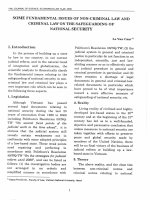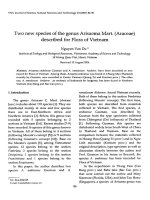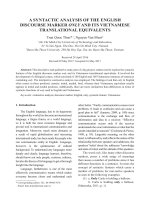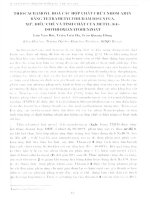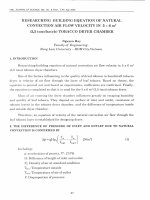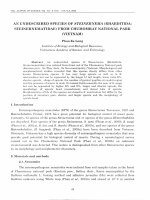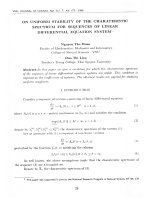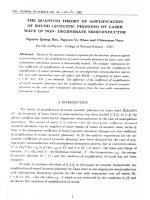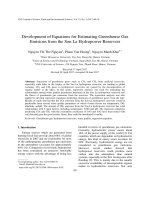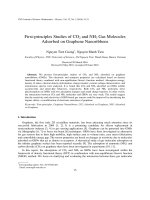DSpace at VNU: Low birth weight of Vietnamese infants is related to their mother's dioxin and glucocorticoid levels
Bạn đang xem bản rút gọn của tài liệu. Xem và tải ngay bản đầy đủ của tài liệu tại đây (395.35 KB, 8 trang )
Environ Sci Pollut Res
DOI 10.1007/s11356-016-6233-0
RESEARCH ARTICLE
Low birth weight of Vietnamese infants is related to their mother’s
dioxin and glucocorticoid levels
Dao Van Tung 1,2 & Teruhiko Kido 3 & Seijiro Honma 3 & Ho Dung Manh 3,4 &
Dang Duc Nhu 3,5 & Rie Okamoto 3 & Shoko Maruzeni 3,6 & Muneko Nishijo 6 &
Hideaki Nakagawa 6 & Pham Thien Ngoc 1 & Ngo Van Toan 1 & Nguyen Ngoc Hung 1 &
Nguyen Hung Minh 7 & Le Ke Son 7
Received: 9 August 2015 / Accepted: 1 February 2016
# Springer-Verlag Berlin Heidelberg 2016
Abstract We aimed to determine the relationship between
dioxin congeners in maternal breast milk and maternal glucocorticoid levels with newborn birth weight after nearly
45 years of use of herbicides in the Vietnam War. The study
subjects comprised 58 mother–infant pairs in a region with
high dioxin levels in the soil (hotspot) and 62 pairs from a
control region. Dioxin levels in maternal breast milk were
measured by HRGC-HRMS. Salivary glucocorticoid levels
were determined by LC-MS/MS. Dioxin congener levels in
mothers from the hotspot were found to be two to fivefold
higher than those in mothers from the control region. Birth
weight was inversely correlated with 2,3,7,8-TeCDD and 2,3,
4,7,8-PeCDF congener levels. The rate of newborns whose
birth weight was less than 2500 g was threefold higher in
the hotspot (12 %) than in the control region (4 %). Salivary
Responsible editor: Philippe Garrigues
* Teruhiko Kido
1
Hanoi Medical University, No. 1 Ton That Tung, Dong Da,
Hanoi, Vietnam
2
Viettiep Hospital, No. 1 Nha Thuong, Le Chan, Hai Phong, Vietnam
3
Faculty of Health Sciences, Institute of Medical Pharmaceutical and
Health Sciences, Kanazawa University, 5-11-80 Kodatsuno,
Kanazawa 920-0942, Japan
4
Faculty of Pharmacy, Lac Hong University, Bien Hoa, Vietnam
5
School of Medicine and Pharmacy, Vietnam National University,
Hanoi, Vietnam
6
Department of Public Health, Kanazawa Medical University, 1-1
Daigaku, Uchinada, Ishikawa, Japan
7
Environment Administration, Ministry of Natural Resources and
Environment, No. 67 Nguyen Du Street, Hanoi, Vietnam
glucocorticoid levels in mothers with low birth weight infants
were significantly higher than those in the normal birth weight
group. Low birth weight of Vietnamese newborns in a hotspot
for dioxin levels is related to some dioxin congener levels and
high glucocorticoid levels in mothers. This finding in mother–
infant pairs suggests that excess maternal glucocorticoid
levels are related to dioxin burden and they result in low birth
weight.
Keywords Dioxin congener . Dioxin hotspot . Vietnam . Low
birth weight . Growth parameter . Glucocorticoid
Introduction
Dioxins are a group of several compounds with similar structures, they greatly vary in toxicity, and are known as
polychlorinated dibenzodioxins (PCDDs), polychlorinated dibenzofurans (PCDFs), and polychlorinated biphenyls (PCBs).
These compounds of highly toxic dioxin or dioxin-like species
are known to be persistent organic pollutants. The compound
2,3,7,8-tetrachlorodibenzo-p-dioxin (TCDD) is one of the
most toxic substances found in the environment (Stellman
et al. 2003). These compounds enter the human body via the
food chain or by respiration and accumulate in the fatty tissue,
where they have a half-life of 7–11 years because of their
lipophilic nature (Milbrath et al. 2009). Dioxins are unwanted
by-products of the manufacture of various chlorinated herbicides and pesticides. Dioxins are also released into the atmosphere when polychlorovinyl substances are incinerated.
PCBs are a class of chemically stable compounds that were
widely used for 50 years in industry as heat-transfer fluids in
capacitors and transformers.
However, the situation in Vietnam differs from that described above. Between 1961 and 1971, the U.S. Air Force
Environ Sci Pollut Res
sprayed over 80 million liters of the defoliant Agent Orange,
which is one of several defoliants containing large amounts of
a toxic dioxin, and other herbicides over more than 10 % of
the surface area of South Vietnam. This spaying was performed to defoliate tropical forests and destroy agricultural
production (Stellman et al. 2003).
Similar to many other persistent chemicals that appear in
breast milk, dioxin levels decrease with time. The highest
levels of TCDD (1832 parts per trillion [ppt]) in breast milk
were recorded in 1970 (Schecter et al. 1995) and declined to
11–20 ppt in samples collected from 2000 subjects during
1985–1988. This significant decrease in dioxin levels in the
soil in sprayed regions is due to the effects of tropical rain,
erosion, and chemical breakdown over the past 45 years.
However, considerably higher levels of dioxins associated
with Agent Orange use have been observed in the soil around
former U.S. airbases in Bien Hoa, Phu Cat, and Da Nang,
which are known as hotspots (Dwernychuk, 2005).
We have reported that dioxin levels in the blood or breast
milk from hotspot residents are three to fivefold higher than
those in a control region in North Vietnam (Kido et al. 2014,
Manh et al. 2014, Sun et al. 2014). A similar study in Seveso
(Italy) showed TCDD levels in females to be fivefold higher
in an exposed region than in a control region after 30 years
(Mocarelli et al. 2008). The results of residential research suggest that dioxins cause adverse effects on human health by
increasing cancer, reproductive problems, immunodeficiency,
and endocrine disruption.
Recently, low doses of dioxins and PCBs have been recognized as having adverse effects on human endocrine and neurogenic health. There are several reports concerning the adverse health effects of dioxins, such as neurodevelopmental
dysfunction, thyroid deficiency, immunodeficiency, and
growth retardation in fetuses (Brouwer et al. 1999, Rogan
&Ragan 2007, Schantz et al. 2003). These chemical toxics,
which include polychlorinated dibenzo-p-dioxins, dibenzofurans, and PCBs, affect children’s growth as a result of prenatal
or postnatal exposure (Wang et al. 2004). Pregnant and nursing women may pass the dioxins and/or PCBs to their newborns via transplacental transfer and by breastfeeding mothers
(Suzuki et al. 2005, Wang et al. 2004). Several studies on
exposure to lower levels of dioxins or PCBs during pregnancy
have shown a relationship with low birth weight and other
growth parameters (Hertz-Picciotto et al. 2005, Patandin
et al. 1998, Sonneborn et al. 2008).
However, in hotspot areas in Vietnam, the effect of lowlevel exposure to dioxins on birth size and growth of newborns has received little attention. Therefore, this study aimed
to evaluate the effect of low dose levels of dioxin on birth
weight and growth parameters of Vietnamese newborns in a
hotspot and in an unexposed region. In addition, we investigated the correlation between individual congeneric dioxin
levels in maternal breast milk and birth weight to identify
the harmful congeners. Furthermore, we analyzed the relation
between maternal glucocorticoid levels and low birth weight
of newborns as a marker for an adverse intrauterine
environment.
Materials and methods
Study region
–
–
Agent Orange/dioxin hotspot
The research areas in this study were in or around Phu
Cat airbase. This area was selected as a dioxin hotspot
because it currently has the highest concentration of
TCDD in the soil. This is one of three dioxin hotspots
in South Vietnam where chemical herbicides were stored
and spilled, and where aircrafts that sprayed Agent
Orange/dioxin were washed, during the Vietnam War
(Dwernychuk 2005).
Control region
The comparison site was a reference region in Kim
Bang district, located in Ha Nam province in North
Vietnam. This site was not exposed to chemical defoliants
during the war, which is why it was selected as the control
region. The hotspot and control region are rural and have
not been affected by industrial pollution.
Population
The study subjects consisted of 58 mother–infant pairs from
the dioxin hotspot and 62 pairs from the control region. The
age of lactating mothers was between 20 and 30 years, with
infants aged between 7 and 16 weeks at the time of sampling.
All lactating mothers were asked to complete a health status
questionnaire to collect information concerning their family,
age, family income, and residence period.
The body mass index (BMI) for lactating mothers and
growth parameters (height, weight, and head and chest circumference) for their newborns were determined by medical
staff. Breast milk (20 ml) and saliva samples (2–3 ml) were
collected from lactating women from both regions in
September 2008 by medical staff. Saliva samples were collected from the hotspot (n = 41) and the non-exposed area
(n = 36) between 08:00 and 10:00 a.m. We did not collect
saliva from lactating mothers who had samples collected in
the afternoon since hormone levels were higher in the morning
than in the afternoon. These samples were stored in chemically cleaned cooling containers and frozen on dry ice for several
days. They were then transported to Japan and stored at
−30 °C until analysis.
The temperature in both regions was approximately 30–
34 °C at the time of study. After local government officials
Environ Sci Pollut Res
and medical staff had explained the purpose of the study to
120 lactating women (58 from the dioxin hotspot and 62 from
the control region), they all agreed to participate.
Analysis of dioxin in breast milk
In this study, dioxin was defined as only PCDDs/PCDFs, not
including PCBs. Breast milk samples were analyzed according to a previously reported method (Tai et al. 2011). After
extraction of fat from 10 g of breast milk, 40–80 pg of 17
13
C12-labeled PCDD/PCDF congeners were added as an internal standard.
A series of purification steps involving alkali digestion and
chromatography on a multi-layer silica gel column and an
active carbon-dispersed silica gel column were applied to separate and collect the PCDDs/PCDFs. The final sample extract
was dried under nitrogen steam and then re-dissolved by
adding 20 ml of nonane containing 40 pg of 13C12-1,2,3,4TCDD and 13C12-1,2,7,8-TCDF as external standards. Finally,
dioxin/furan/fractions were determined using high-resolution
mass spectrometry (MS station-JMS-700; JEOL, Tokyo,
Japan) coupled with gas chromatography (HP-6980;
Hewlett-Packard, Palo Alto, CA, USA).
Dioxin analysis was carried out in a selected ion monitoring mode at a resolution of 10,000, and the obtained values
were converted into toxic equivalents (TEQs) using the World
Health Organization toxicity equivalency factors (Van den
Berg et al. 2006). Quality control and quality assurance were
ensured following the guidelines described in the Japanese
Industrial Standard. Eligibilities for the analysis of dioxin
were certified using the natural reference powder milk
CRM607, which was provided by the European Commission.
The recovery rate was typically in the range of 60–95 %,
and the detection limits were determined at a signal-to-noise
ratio of three on a lipid basis. Congener levels below the limits
of detection were set to 50 % of these limits.
Analysis of salivary steroids by LC-MS/MS
The analytical procedure for the salivary glucocorticoid hormone assay using LC-MS/MS was as reported previously in
detail (Kido et al. 2014).
Estimation of the daily dioxin intake of infants from breast
milk
The daily dioxin intake (DDI) was estimated as per previous
publications by assuming that the infant (0–24 weeks) consumes 800 ml of milk per day (Schecter et al. 2001, Tai et al.
2011) and taking the weight of the infant at the time into
account. The intake value was calculated using the following
equation:@@@
Statistical analyses
The data are shown as mean and standard deviation
(SD) for normal and non-normal distribution, as determined using the Shapiro–Wilk test. Student’s t test was
used in the case of normal distribution, and the chisquared test was used to compare two groups according
to continuous or categorical variables. The Mann–
Whitney U or Kruskal–Wallis tests were used in the
case of non-normal distribution to compare two or more
than two groups, respectively. Pearson’s correlation coefficients were calculated. The significance level was set
at p < 0.05. All statistical analyses were carried out
using SPSS 12.0 software and Microsoft Excel 2010.
Ethics
The Medical Ethics Committee of Kanazawa University approved this study. The permission number was Health 89 in
2007. All lactating mothers provided written informed
consent.
Results
Comparison of dioxin congener levels in breast milk
of lactating mothers from the dioxin hotspot
and unexposed region
The demographic characteristics of the mothers were not
significantly different between the dioxin hotspot and
the unexposed region in Vietnam, including mean
values for residency, age, weight, height, BMI, and family income.
The TEQs of dioxin congener levels in the milk of
lactating mothers in the hotspot and unexposed region
are shown in Table 1. The levels of most dioxin congeners
were significantly higher in the hotspot than in the unexposed region (p < 0.001). The TEQ level of the most toxic
congener, 2,3,7,8-TeCDD, was 3.3-fold higher in the
hotspot than in the unexposed region. There was no significant difference in the TEQ of 2,3,7,8-TeCDF levels
between the two regions. In addition, the TEQ of PCDD
levels, TEQ of PCDF levels, and total TEQ of
PCDD/PCDF levels in the breast milk of primiparae were
significantly higher than those in multiparae.
Comparison of body size and DDI in infants
from the hotspot and unexposed region
Comparison of the size of infants and DDI are shown in
Table 2. The DDI from breast milk was three to fourfold
higher in the hotspot than in the unexposed region for infants
Environ Sci Pollut Res
Table 1 Dioxin congener levels
in maternal breast milk in the
hotspot and control region
Dioxin congener (pg/g of lipid)
PCDDs
PCDFs
Total
TEQ “2,3,7,8-TeCDD”
Control region
Hotspot region
N
Mean
SD
N
62
0.458
0.345
58
Mean
1.514
SD
H/Ca
0.712
3.3
p value
***
TEQ ”1,2,3,7,8-PeCDD“
62
1.314
0.594
58
4.434
1.816
3.4
***
TEQ ”1,2,3,4,7,8-HxCDD“
62
0.065
0.026
58
0.209
0.085
3.2
***
***
TEQ ”1,2,3,6,7,8-HxCDD“
62
0.138
0.061
58
0.741
0.349
5.4
TEQ ”1,2,3,7,8,9-HxCDD“
62
0.061
0.026
58
0.281
0.118
4.7
***
TEQ ”1,2,3,4,6,7,8-HpCDD“
62
0.025
0.009
58
0.141
0.062
5.7
***
TEQ ”OCDD“
62
0.004
0.002
58
0.021
0.009
5.9
***
TEQ ”2,3,7,8-TeCDF”
62
0.067
0.029
58
0.070
0.033
1.1
TEQ “1,2,3,7,8-PeCDF”
62
0.014
0.008
58
0.065
0.037
4.6
***
TEQ “2,3,4,7,8-PeCDF”
62
0.914
0.333
58
1.909
0.716
2.1
***
TEQ “1,2,3,4,7,8-HxCDF”
62
0.196
0.072
58
1.592
0.845
8.1
***
TEQ “1,2,3,6,7,8-HxCDF”
62
0.166
0.062
58
0.926
0.451
5.6
***
TEQ “1,2,3,7,8,9-HxCDF”
62
0.014
0.008
58
0.041
0.029
2.9
***
TEQ “2,3,4,6,7,8-HxCDF”
62
0.055
0.029
58
0.159
0.063
2.9
***
TEQ “1,2,3,4,6,7,8-HpCDF”
62
0.015
0.008
58
0.183
0.120
12.4
***
TEQ “1,2,3,4,7,8,9-HpCDF”
62
0.002
0.001
58
0.018
0.012
9.9
***
***
TEQ “OCDF”
62
0.000
0.000
58
0.001
0.001
4.8
TEQ “Total PCDDs”
62
2.064
0.931
58
7.342
2.865
3.6
***
TEQ “Total PCDFs”
62
1.442
0.482
58
4.965
2.054
3.4
***
TEQ “PCDDs + PCDFs”
62
3.506
1.354
58
12.307
4.431
3.5
***
Data are shown as mean ± SD and were analyzed using the Mann–Whitney U test
TEQ toxic equivalent (pg/g of lipid)
***p < 0.001
a
Ratios of mean dioxin levels in the hotspot and control region
aged 8–9 or 12–14 weeks. However, there were no significant
differences in growth parameters (height, weight, head and
Table 2 Comparison of body
size of infants and the DDI in the
two age groups from the hotspot
and control regions
Infant group
8–9 weeks
12–14 weeks
chest circumference) between the hotspot and unexposed
region.
Index
Control region
Hotspot region
p value
N
Mean
SD
N
Mean
SD
Age (weeks)
Height (cm)
Weight (g)
Head (cm)
Chest (cm)
DDI (TEQ pg/kg/d)
Age (weeks)
Height (cm)
Weight (g)
Head (cm)
20
20
20
20
20
20
41
41
41
41
9.7
59.5
5433
39.0
40.0
18.0
14.6
62.2
6277
40.7
0.88
2.35
481
1.19
1.49
8.97
2.02
2.42
821
1.74
32
32
32
32
32
32
23
23
23
23
9.0
59.8
5415
39.2
39.6
54.2
13.9
62.4
6108
40.9
1.69
3.10
963
1.38
2.60
28.20
1.84
2.52
807
1.57
0.090
0.642
0.937
0.623
0.543
0.000
0.139
0.767
0.430
0.672
Chest (cm)
DDI (TEQ pg/kg/d)
41
41
41.5
12.3
2.11
4.93
23
22
40.9
42.7
2.39
23.96
0.312
0.000
Data are shown as mean ± SD. Statistical significance was tested using Student’s t test
DDI daily dioxin intake
Environ Sci Pollut Res
Correlations between dioxin congener levels in maternal
breast milk and birth weight or infant size in the hotspot
and unexposed region
The rate of newborns with low birth weight (<2500 g) was
higher in the hotspot (n = 6, 12.0 %) than in the unexposed
region (n = 2, 4.0 %).
The correlations between dioxin congeners and birth
weight are shown in Table 3. The TEQs of 2,3,7,8-TeCDD
and 2,3,4,7,8-PeCDF levels showed a significant negative correlation with birth weight (Fig. 1). After birth, there was no
significant correlation between infant size and dioxin isomer
levels at either 8–9 or 12–14 weeks.
Comparison of salivary glucocorticoid levels and total
TEQ of dioxin levels in breast milk of lactating mothers
Table 4 shows the dioxin levels in maternal breast milk and
salivary cortisol and cortisone levels from lactating mothers
(n = 78) for the three subgroups based on their birth weight of
babies. Salivary cortisol and cortisone levels in lactating
mothers were significantly higher in the group of low birth
Table 3
PCDDs
PCDFs
Total
Discussion
Although the end of Operation Ranch Hand was 45 years ago,
dioxin residue levels are still high in the soil and in the local
residents. This study is important for assessing adverse effects
on human health due to dioxin exposure in the second and
third generations of the Vietnamese population after the war.
We studied a dioxin hotspot and an unexposed region to evaluate the effect of dioxin congeners on growth parameters of
Vietnamese newborns in a hotspot. Our study showed that
almost 17 dioxin congeners in maternal breast milk (see
Table 1) in the hotspot were higher than those in the
Correlations between dioxin congener levels in maternal breast milk and birth weight and infant size
Birth
8–9 weeks old
12–14 weeks old
N = 120
N = 52
N = 64
Weight
Height
Weight
Head
Chest
Height
Weight
Head
Chest
TEQ B2,3,7,8-TeCDD^
TEQ B1,2,3,7,8-PeCDD^
TEQ B1,2,3,4,7,8-HxCDD^
TEQ B1,2,3,6,7,8-HxCDD^
−0.184*
−0.147
−0.158
−0.127
−0.148
−0.145
−0.028
−0.150
−0.038
−0.068
0.027
−0.097
0.022
−0.040
0.017
−0.021
−0.098
−0.095
−0.005
−0.110
−0.037
0.098
0.069
0.063
−0.052
−0.047
−0.030
−0.054
0.126
0.124
0.112
0.071
−0.052
−0.104
−0.034
−0.068
TEQ B1,2,3,7,8,9-HxCDD^
TEQ B1,2,3,4,6,7,8-HpCDD^
TEQ BOCDD^
TEQ B2,3,7,8-TeCDF^
TEQ B1,2,3,7,8-PeCDF^
TEQ B2,3,4,7,8-PeCDF^
TEQ B1,2,3,4,7,8-HxCDF^
TEQ B1,2,3,6,7,8-HxCDF^
TEQ B1,2,3,7,8,9-HxCDF^
TEQ B2,3,4,6,7,8-HxCDF^
TEQ B1,2,3,4,6,7,8-HpCDF^
TEQ B1,2,3,4,7,8,9-HpCDF^
TEQ ^OCDF^
TEQ BTotal PCDDs^
−0.145
−0.098
−0.145
−0.118
−0.156
−0.206*
−0.131
−0.141
−0.05
−0.164
−0.122
−0.093
−0.048
−0.159
−0.061
0.065
0.016
−0.230
0.025
−0.238
−0.034
−0.053
0.010
0.016
0.085
0.099
0.060
−0.142
−0.047
0.053
0.021
−0.170
−0.022
−0.215
−0.059
−0.086
−0.032
−0.023
0.005
0.064
−0.024
−0.062
0.027
0.065
0.014
0.022
0.122
−0.125
0.052
0.036
−0.007
0.084
0.115
0.112
0.134
−0.019
−0.091
−0.018
−0.025
−0.083
−0.014
−0.226
−0.068
−0.114
−0.021
−0.062
−0.030
0.032
0.019
−0.097
0.069
0.133
0.178
−0.132
0.018
0.074
0.086
0.103
0.081
0.058
0.095
0.136
−0.015
0.067
−0.039
−0.030
−0.041
−0.033
0.026
−0.019
−0.003
−0.006
0.008
−0.006
0.015
0.017
−0.069
−0.049
0.092
0.091
0.108
−0.047
0.040
0.195
0.088
0.105
0.026
0.080
0.061
0.085
−0.072
0.121
−0.039
−0.058
−0.110
−0.016
0.050
−0.046
−0.014
−0.013
−0.024
−0.008
0.003
−0.032
−0.076
−0.086
TEQ BTotal PCDFs^
TEQ BPCDDs + PCDFs^
−0.167
−0.168
−0.110
−0.135
−0.123
−0.088
−0.011
−0.017
−0.137
−0.117
0.087
0.078
−0.007
−0.032
0.121
0.125
−0.022
−0.060
Head head circumference, chest chest circumference
*p < 0.05
weight infants (<2500 g) than in the normal weight group
(>2800 g). Although the 2,3,7,8-TeCDD, TEQ 2,3,4,7,8PeCDF, and total TEQ PCDD/Fs were higher in the group
of low birth weight infants (<2500 g), the statistic were not
significant. The reason for the statistic not being significant
might be due to a large difference in the number of low birth
weight infants (3) and the number of normal birth weight
infants (66).
Environ Sci Pollut Res
Fig. 1 Correlations between birth weight and dioxin congeners in maternal breast milk
There have been several studies on dioxins and their adverse effects on human health, especially during the prenatal
and early postnatal periods. The effects of maternal exposure
to dioxins on the infant may not manifest themselves immediately and could affect developing organs and lead to disease
onset later in life (Konishi et al. 2009, Tai et al. 2011). Our
study showed that the rate of low birth weight infants
(<2500 g) was threefold higher in the hotspot than in the
unexposed region. Overall, our findings are in agreement with
the report by Taylor et al. (1984) on the number of risk factors
for infants born with low birth weight. These authors also
reported an increased rate of low birth weight infants and
shortened gestational age among women who were occupationally exposed to toxic chemicals, such as TCDD or PCBs
(Taylor et al. 1989). Similarly, an epidemiological study that
aimed to identify dioxin congeners that cause low fetal birth
weight reported that 2,3,4,7,8-PeCDF was mainly responsible
for this effect (Konishi et al. 2009). Our study showed that two
of the 17 dioxin congeners studied in maternal breast milk,
unexposed region, and some congeners were related to low
weight birth. We also evaluated the relation between maternal
corticoids levels and low birth weight.
Recent studies have shown that levels of dioxin in humans
are three to fivefold higher in hotspots than in unexposed
regions (Kido et al. 2014, Manh et al. 2014). Mothers who
are exposed to dioxins could potentially expose their offspring
to dioxin during pregnancy as a result of circulation of maternal blood through the placenta (Suzuki et al. 2005). A previous report estimated that an infant who is breastfed for 1 year
accumulates a dose of dioxin that is sixfold higher than that in
an infant who is not breastfed (Lorber & Phillips 2002). Our
study showed that DDI from breast milk in infants was approximately three to fourfold higher in the hotspot than in the
unexposed region at 8–9 weeks, decreasing to threefold at 12–
14 weeks (Tables 1 and 2). Hue et al. (2014) studied a different
hotspot (Da Nang) to our study and also showed a higher
average DDI from breast milk than in the corresponding control region.
Table 4 Salivary glucocorticoid
and dioxin levels in breast milk in
lactating mothers with division
into three groups based on birth
weight
Baby group
Cortisol (ng/ml)
Cortisone (ng/ml)
TEQ B2,3,7,8-TeCDD^
TEQ B2,3,4,7,8-PeCDF^
TEQ BPCDDs + PCDFs^
Group 1
Group 2
Group 3
<2500
2500–2800
>2800
p value
N
Mean
SD
N
Mean
SD
N
Mean
SD
p1–3
3
3
3
3
3
6.52
20.94
1.00
1.56
9.09
4.39
5.34
0.89
1.32
8.21
9
9
9
9
9
3.2
14.63
1.50
1.76
10.29
3.4
9.86
0.80
0.88
6.30
66
66
66
66
66
2.19
11.71
1.01
1.43
8.05
1.53
6.67
0.76
0.78
5.57
*
*
NS
NS
NS
Data are shown as mean ± SD, and were analyzed using the Kruskal–Wallis test for more than two groups and the
Mann–Whitney U test for two groups
TEQ toxic equivalent (pg/g of lipid), NS not significant
p1–3 comparison between Group 1 and Group 3
*p < 0.05
Environ Sci Pollut Res
namely 2,3,7,8-TeCDD and 2,3,4,7,8-PeCDF, reduced birth
weight (Table 3 and Fig. 1). This is the first such finding
regarding the relationship between the frequency of low birth
weight and dioxin congeners in Vietnam.
The mechanism by which dioxins induce low birth
weight in pregnancy remains unknown. We found that salivary cortisol and cortisone levels in lactating mothers in
the low birth weight group (<2500 g) were significantly
higher than those in the normal weight group (>2800 g).
Based on our findings, we propose a mechanism whereby
exposure to excess glucocorticoids inhibits fetal development, with cortisol likely causing low fetal birth weight. We
previously reported that glucocorticoid levels in lactating
mothers from a hotspot region were higher than those from
non-exposed regions, with a strong correlation between
glucocorticoids (cortisol and cortisone) and dioxin levels
in maternal breast milk (Kido et al. 2014). Several reports
have shown that fetal growth is retarded by excess glucocorticoids or pharmacological doses of dexamethasone
(Goedhart et al. 2010, Hauser et al. 2007, Koppe et al.
1977, Thorp et al. 2002). Furthermore, a recent study in rats
demonstrated that fetuses that were overexposed to high
levels of maternal glucocorticoids had intrauterine growth
retardation (Kou et al. 2014). However, little is known
about the levels of cortisol and how they may affect fetal
and postnatal growth.
The placental enzyme 11β-hydroxysteroid dehydrogenase
(11β-HSD) is known to regulate cortisol levels in the fetus to
protect against excess maternal cortisol (Welberg et al. 2000).
This enzyme has two forms of 11β-HSD, types 1 and 2. The
role of type 2 (11β-HSD2) is to oxidize biologically active
cortisol into inactive cortisone (Murphy et al. 1974). In
humans, lower placental 11β-HSD2 activity is correlated with
lower birth weight, and infants homozygous for deleterious
mutations of the 11β-HSD2 gene have a lower birth weight
(Reynolds 2013). Exposure of the developing fetus to excess
cortisol leads to fetal hypothalamic–pituitary–adrenal axis activation, which is associated with low birth weight and longterm adverse outcomes, including metabolic and brain sequelae (Moisiadis & Matthews 2014). Another action of 11β-HSD
may be to protect cartilage against extensive cortisol action,
even in the presence of high cortisol levels. These results
indicate that cortisol and its related activating enzyme contribute to the development of catabolism.
In our study, although the DDI from breast milk at 12–
14 weeks or longer was higher in the hotspot than in the unexposed area (Table 2), infant body size was not affected
(Table 3). This finding suggests that, although low dioxin
levels do not continue to affect body size (weight, height, head
or chest circumference) of children after birth, they may affect
metabolism in children as a result of endocrine disruption.
Further research focusing on pediatric endocrinology is necessary to determine any possible adverse health effects of dioxin.
Acknowledgments The authors thank the medical staff at Kim Bang
and Phu Cat medical centers for their assistance. We would also like to
thank all of the women and their families who participated in the study.
Furthermore, we thank the officers of the 10–80 Division, Hanoi Medical
University, Vietnam, for making this study possible.
This study was supported by Grant-in-Aid for Scientific Research (A)
from the Japan Society for the Promotion of Science (19209021.) and
Pfizer Health Research Foundation.
Compliance with ethical standards
Ethics The Medical Ethics Committee of Kanazawa University approved this study. The permission number was Health 89 in 2007. All
lactating mothers provided written informed consent.
References
Brouwer A, Longnecker MP, Birnbaum LS, Cogliano J, Kostyniak P,
Moore J, Schantz S, Winneke G (1999) Characterization of potential
endocrine-related health effects at low-dose levels of exposure to
PCBs. Environmental health perspectives 107(Suppl 4):639–6s49
Dwernychuk LW (2005) Dioxin hot spots in Vietnam. Chemosphere 60:
998–999
Goedhart G, Vrijkotte TG, Roseboom TJ, van der Wal MF, Cuijpers P,
Bonsel GJ (2010) Maternal cortisol and offspring birthweight: results
from a large prospective cohort study. Psychoneuroendocrinology 35:
644–652
Hauser J, Dettling-Artho A, Pilloud S, Maier C, Knapman A, Feldon J,
Pryce CR (2007) Effects of prenatal dexamethasone treatment on
postnatal physical, endocrine, and social development in the common marmoset monkey. Endocrinology 148:1813–1822
Hertz-Picciotto I, Charles MJ, James RA, Keller JA, Willman E, Teplin S
(2005) In utero polychlorinated biphenyl exposures in relation to
fetal and early childhood growth. Epidemiology 16:648–656
Hue NT, Nam VD, Thuong NV, Huyen NT, Phuong NT, Hung NX, Tuan
NH, Son LK, Minh NH (2014) Determination of PCDD/Fs in breast
milk of women living in the vicinities of Da Nang Agent Orange hot
spot (Vietnam) and estimation of the infant's daily intake. The
Science of the total environment 491–492:212–218
Kido T, Dao TV, Ho MD, Duc Dang N, Pham NT, Okamoto R, Pham TT,
Maruzeni S, Nishijo M, Nakagawa H, Honma S, Le SK, Nguyen
HN (2014) High cortisol and cortisone levels are associated with
breast milk dioxin concentrations in Vietnamese women. European
journal of endocrinology / European Federation of Endocrine
Societies 170:131–139
Konishi K, Sasaki S, Kato S, Ban S, Washino N, Kajiwara J, Todaka T,
Hirakawa H, Hori T, Yasutake D, Kishi R (2009) Prenatal exposure
to PCDDs/PCDFs and dioxin-like PCBs in relation to birth weight.
Environ Res 109:906–9s13
Koppe JG, Smolders-de Haas H, Kloosterman GJ (1977) Effects of glucocorticoids during pregnancy on the outcome of the children directly after birth and in the long run. European journal of obstetrics,
gynecology, and reproductive biology 7:293–299
Kou H, Liu Y, Liang G, Huang J, Hu J, Yan YE, Li X, Yu H, He X, Zhang
B, Zhang Y, Feng J, Wang H (2014) Maternal glucocorticoid elevation and associated blood metabonome changes might be involved
in metabolic programming of intrauterine growth retardation in rats
exposed to caffeine prenatally. Toxicol Appl Pharmacol 275:79–87
Lorber M, Phillips L (2002) Infant exposure to dioxin-like compounds in
breast milk. Environmental health perspectives 110:A325–A332
Environ Sci Pollut Res
Manh HD, Kido T, Okamoto R, Xianliang S, le Anh T, Supratman S,
Maruzeni S, Nishijo M, Nakagawa H, Honma S, Nakano T,
Takasuga T, Nhu DD, Hung NN, le Son K (2014) Serum dioxin
levels in Vietnamese men more than 40 years after herbicide
spraying. Environmental science & technology 48:3496–3503
Milbrath MO, Wenger Y, Chang CW, Emond C, Garabrant D, Gillespie
BW, Jolliet O (2009) Apparent half-lives of dioxins, furans, and
polychlorinated biphenyls as a function of age, body fat, smoking
status, and breast-feeding. Environmental health perspectives 117:
417–425
Mocarelli P, Gerthoux PM, Patterson DG Jr, Milani S, Limonta G,
Bertona M, Signorini S, Tramacere P, Colombo L, Crespi C,
Brambilla P, Sarto C, Carreri V, Sampson EJ, Turner WE,
Needham LL (2008) Dioxin exposure, from infancy through puberty, produces endocrine disruption and affects human semen quality.
Environmental health perspectives 116:70–77
Moisiadis VG, Matthews SG (2014) Glucocorticoids and fetal programming part 1: outcomes. Nature reviews. Endocrinology 10:391–411
Murphy BE, Clark SJ, Donald IR, Pinsky M, Vedady D (1974)
Conversion of maternal cortisol to cortisone during placental transfer to the human fetus. American journal of obstetrics and gynecology 118:538–541
Patandin S, Koopman-Esseboom C, de Ridder MA, Weisglas-Kuperus N,
Sauer PJ (1998) Effects of environmental exposure to
polychlorinated biphenyls and dioxins on birth size and growth in
Dutch children. Pediatr Res 44:538–545
Reynolds RM (2013) Glucocorticoid excess and the developmental origins of disease: two decades of testing the hypothesis—2012 Curt
Richter Award Winner. Psychoneuroendocrinology 38:1–11
Rogan WJ, Ragan NB (2007) Some evidence of effects of environmental
chemicals on the endocrine system in children. Int J Hyg Environ
Health 210:659–667
Schantz SL, Widholm JJ, Rice DC (2003) Effects of PCB exposure on
neuropsychological function in children. Environmental health perspectives 111:357–576
Schecter A, Dai LC, Thuy LT, Quynh HT, Minh DQ, Cau HD, Phiet PH,
Nguyen NT, Constable JD, Baughman R et al (1995) Agent Orange
and the Vietnamese: the persistence of elevated dioxin levels in
human tissues. Am J Public Health 85:516–522
Schecter A, Cramer P, Boggess K, Stanley J, Papke O, Olson J, Silver A,
Schmitz M (2001) Intake of dioxins and related compounds from
food in the U.S. population. Journal of toxicology and environmental health. Part A 63:1–18
Sonneborn D, Park HY, Petrik J, Kocan A, Palkovicova L, Trnovec T,
Nguyen D, Hertz-Picciotto I (2008) Prenatal polychlorinated
biphenyl exposures in eastern Slovakia modify effects of social factors on birthweight. Paediatr Perinat Epidemiol 22:202–213
Stellman JM, Stellman SD, Christian R, Weber T, Tomasallo C (2003)
The extent and patterns of usage of Agent Orange and other herbicides in Vietnam. Nature 422:681–687
Sun XL, Kido T, Okamoto R, Manh HD, Maruzeni S, Nishijo M,
Nakagawa H, Honma S, Nakano T, Takasuga T, Nhu DD, Hung
NN, le Son K (2014) Relationship between dioxin and steroid hormones in sera of Vietnamese men. Biomarkers : biochemical indicators of exposure, response, and susceptibility to chemicals 19:
236–240
Suzuki G, Nakano M, Nakano S (2005) Distribution of PCDDs/PCDFs
and Co-PCBs in human maternal blood, cord blood, placenta, milk,
and adipose tissue: dioxins showing high toxic equivalency factor
accumulate in the placenta. Biosci Biotechnol Biochem 69:1836–
1847
Tai PT, Nishijo M, Kido T, Nakagawa H, Maruzeni S, Naganuma R, Anh
NT, Morikawa Y, Luong HV, Anh TH, Hung NN, le Son K, Tawara
K, Nishijo H (2011) Dioxin concentrations in breast milk of
Vietnamese nursing mothers: a survey four decades after the herbicide spraying. Environmental science & technology 45:6625–6632
Taylor PR, Lawrence CE, Hwang HL, Paulson AS (1984)
Polychlorinated biphenyls: influence on birthweight and gestation.
American journal of public health 74:1153–1154
Taylor PR, Stelma JM, Lawrence CE (1989) The relation of
polychlorinated biphenyls to birth weight and gestational age in
the offspring of occupationally exposed mothers. American journal
of epidemiology 129:395–406
Thorp JA, Jones PG, Knox E, Clark RH (2002) Does antenatal corticosteroid therapy affect birth weight and head circumference?
Obstetrics and gynecology 99:101–108
Van den Berg M, Birnbaum L, Denison M, De Vito M, Farland W, Feeley
M, Fiedler H, Hakansson H, Hanberg A et al (2006) The (2005)
World Health Organization re-evaluation of human and mammalian
toxic equivalency factors for dioxins and dioxin-like compounds.
Toxicological Sciences 93:223–241
Wang SL, Lin CY, Guo YL, Lin LY, Chou WL, Chang LW (2004) Infant
exposure to polychlorinated dibenzo-p-dioxins, dibenzofurans and
biphenyls (PCDD/Fs, PCBs)–correlation between prenatal and postnatal exposure. Chemosphere 54:1459–1473
Welberg LA, Seckl JR, Holmes MC (2000) Inhibition of 11betahydroxysteroid dehydrogenase, the foeto-placental barrier to maternal glucocorticoids, permanently programs amygdala GR mRNA
expression and anxiety-like behaviour in the offspring. The
European journal of neuroscience 12:1047–1054
